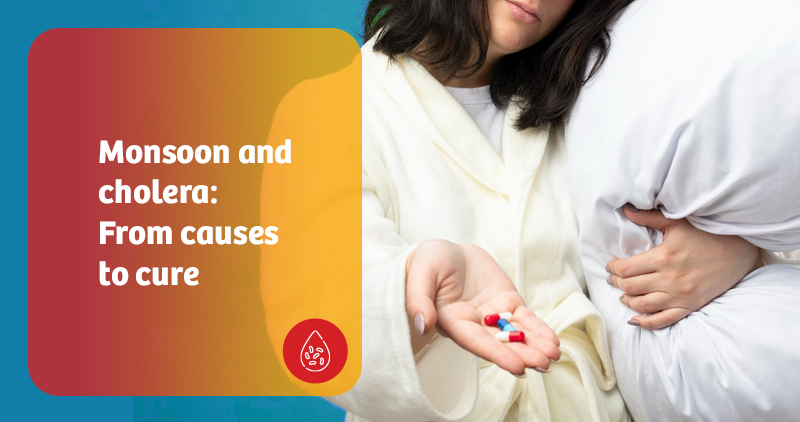

By Dr Wasimahmed M Sachora
Consultant Internal Medicine
Aug 06, 2025
Cholera is an acute diarrhea disease caused by the bacterium vibrio cholerae. It primarily affects the small intestine, leading to severe dehydration due to sudden loss of fluids through watery diarrhea and vomiting. This illness typically spreads through food or water contaminated with human faeces, making it especially common in areas with poor sanitation and limited access to clean water.
Without timely treatment, cholera can be life-threatening, particularly for children, elderly people, and individuals with weakened immunity. However, with prompt care, recovery is often quick and complete.
Cholera is transmitted through the ingestion of contaminated food or water. Key causes include
Once introduced, cholera can spread rapidly in communities lacking basic hygiene and sanitation.
Cholera symptoms can develop within a few hours after infection or may take up to five days to appear. Although some individuals may remain asymptomatic, they can still transmit infection.
Others may experience
Signs of severe dehydration include
If untreated, dehydration can quickly escalate to shock, kidney failure, or even death.
1. Clinical evaluation
Doctors assess symptoms and exposure history. Sudden watery diarrhea, vomiting, and signs of dehydration in areas with cholera outbreaks strongly suggest the infection.
2. Stool culture
A stool sample is tested in a lab to confirm the presence of vibrio cholerae. Though accurate, this process takes 24–48 hours and may not be feasible in emergency settings.
3. Rapid diagnostic tests (RDTs)
These tests deliver results within minutes using stool samples. They are particularly beneficial for quick diagnosis during outbreaks in resource-limited areas.
4. PCR testing
PCR detects bacterial DNA in stool samples and is highly sensitive; however, it requires specialised equipment and is typically used in advanced laboratories.
Cholera treatment: Act fast, save lives
The foundation of treating cholera is the replacement of fluids and electrolytes.
1. Oral rehydration therapy (ORT)
ORS (Oral rehydration salts) mixed with clean water is the first treatment. Even when vomiting, patients are encouraged to take ORS in small, frequent sips.
2. Intravenous (IV) fluids
In severe cases, IV fluids are administered immediately to combat shock and severe dehydration. Ringer’s lactate solution is commonly used.
3. Antibiotics
Antibiotics may be used in serious cases to reduce the duration of diarrhea and the amount of bacteria shed. However, not all patients need them.
4. Zinc supplements
Especially beneficial for children, zinc helps shorten the duration of diarrhea and supports immune and intestinal health.
If left untreated, cholera can lead to
With immediate treatment, most individuals recover without lasting complications.
1. Drink safe water
2. Practice good sanitation
3. Maintain hand hygiene
4. Follow safe food practices
5. Community education
6. Vaccination
Early medical attention is critical in managing cholera. At KD Hospital, our team of best internal medicine specialists in Ahmedabad are equipped to provide immediate and comprehensive care for cholera and other waterborne infections. If you suspect exposure or experience symptoms, don’t delay—consult a doctor to avoid serious complications.
1. Can cholera spread from person to person?
Cholera primarily spreads through contaminated food or water rather than through direct contact between people. Neglecting hygiene, such as failing to wash hands after using the toilet, can heighten the risk.
2. How soon do symptoms appear?
Symptoms typically show up between a few hours and five days after exposure to the bacteria.
3. Is cholera found everywhere?
Cholera is more common in regions with inadequate sanitation, poor water treatment, or during natural disasters. Well-developed areas rarely report outbreaks.
4. Is bottled water a foolproof protection?
While safer, bottled water alone doesn’t guarantee protection. Always ensure food is clean, hands are washed, and ice or uncooked items are avoided if water safety is uncertain.
5. Can someone get cholera more than once?
Yes. Immunity after infection is short-lived, so reinfection is possible.
6. Are there long-term effects after recovery?
With proper treatment, most individuals make a full recovery. However, delaying care can lead to complications such as kidney damage.
7. Can animals carry cholera?
Cholera is a human disease and is not spread by pets or animals.
8. How can communities prevent outbreaks?
By ensuring access to clean water, proper waste disposal, hygiene education, early diagnosis, and vaccination in high-risk areas.
Cholera is dangerous but preventable and treatable. With timely action, clean habits, and strong community awareness, we can reduce its spread and save lives. Let’s work together to build a healthier, safer future.